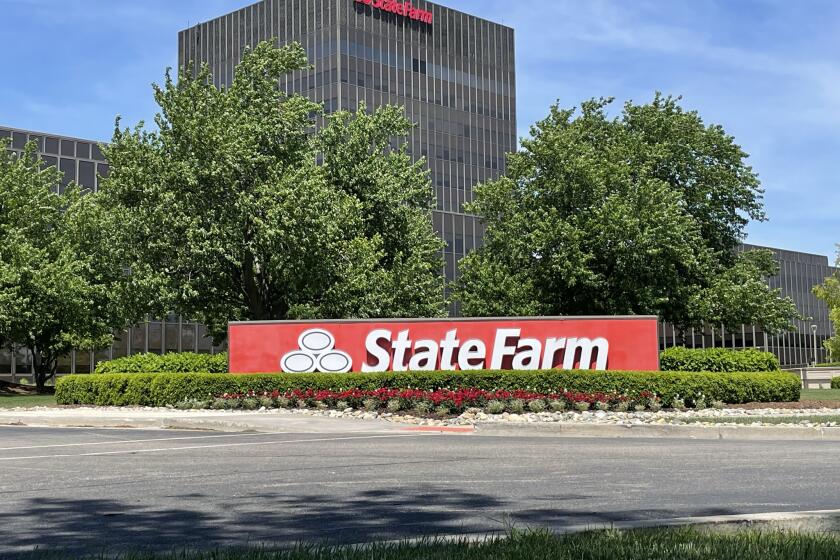Just a Speed Bump?
- Share via
Cruising along like one of the luxury motor homes it produces, Fleetwood Enterprises Inc. spent most of the last five years rolling up impressive sales gains as the nation’s leading producer of recreational vehicles and factory-built houses.
But just as the road ahead seems clear for record sales of the vacation vehicles popular among retirees and the ready-built homes embraced by rural renters, the Riverside-based manufacturer has hit some potholes.
Fleetwood’s share of the fast-growing manufactured housing industry has slipped during the last two years as the company has struggled to sort out capacity and retailer headaches. Fleetwood now appears in danger of losing its perch atop the industry.
Meanwhile, the company expects flat sales of its recreational vehicles this year despite the strong economy, low unemployment and a booming stock market--a combination that would typically fuel sales.
Fleetwood has blamed its RV sales slowdown on poor weather during the traditional spring buying season. But some some analysts say Fleetwood vehicles have become too pricey and that the company has been slow to react to industry changes. It was years behind competitors, for example, in introducing popular “slide-out” sections to increase the roominess of its motor homes.
Wall Street has taken a dim view of Fleetwood’s travails. Although the company--which posted a profit of $125 million on $2.9 billion in sales for its fiscal year ended April 30--bought back 23% of its outstanding shares in the last year to boost stockholder value, the share price has dropped about 17% since last fall.
“The company itself has struggled, and both of the industries they are in are also struggling right now,” said Robert Curran, an analyst at stock brokerage Merrill Lynch.
Fleetwood officials acknowledge that this year’s financial picture is nothing to brag about, but they say there’s no reason for alarm.
“I’ve been in the business for 50 years and there’s always been growth and changes along with some ups and downs,” said John C. Crean, Fleetwood’s 72-year-old founder and chief executive. “We’re not going to panic if things get a little slow.”
Since going public in 1965, Fleetwood has had several opportunities to panic as it endured dramatic downturns. But the company has managed to rebound each time.
After the oil embargo of 1973, for example, RV sales plunged and the company’s stock lost more than 90% of its value before recovering. In the early 1980s, rising oil prices and a recession sent Fleetwood shares spiraling down by about 80%. And during the recession of 1991, a sales drop pushed the stock down about 50%.
Fleetwood’s current problems are minor “blips” compared with those incidents, said Paul Bingham, Fleetwood’s chief financial officer. Though Fleetwood is concerned about its lost market share, several factors bode well for the company’s long-term future, he said.
A huge number of baby boomers is entering the age group that has been the recreational vehicle industry’s most reliable source of customers. A recent study by the University of Michigan said the pool of consumers aged 45 to 54 should balloon by 10 million, to more than 70 million, early in the next century.
Industry officials reject suggestions that this new generation of potential buyers will have less of an appetite for recreational vehicles than did their predecessors. Features such as computer modem hook-ups, satellite dishes and fully equipped kitchens and bathrooms have been designed into the latest models to boost their appeal.
Though Fleetwood’s market share has declined to about 26% of the industry, from about 30% five years ago, the company remains the dominant player in each of three RV categories: bus-like motor homes, towable travel trailers and smaller folding trailers.
Fleetwood expects to regain lost ground with recent improvements, including the slide-out sections that add about 24 square feet to a motor home’s interior. The feature is one of the industry’s most important advances in years and is a big draw for buyers looking for less-cramped quarters--something Fleetwood realized later than its competitors.
“It was my fault that we were slow with the slide-out,” said Crean, who remains closely involved in product development and market strategy despite spending more time working from his Newport Beach home than at the company’s Riverside offices.
“It was my decision to hold off on the slide-out because I’ve seen a lot of things come and go in this industry. But it appears that is here to stay.”
Riverside County dealer Bob Miller said Fleetwood faces sharper competition than ever before in the RV market.
“Fleetwood is still No. 1, but the rest of the industry has been catching up the past few years,” he said. “Their competitors have been pretty aggressive with price and quality. I think Fleetwood still makes the best motor homes, but they are not always the quickest with new trends, whether it’s a slide-out option or new floor plans.”
Miller said Fleetwood’s challenge will be to create affordable vehicles with enough innovations to capture the discretionary dollars of aging baby boomers who might otherwise spend their cash on European vacations, sport-utility vehicles or computers.
Whereas older, more affluent segments of the population are expected to prop up the RV market, Fleetwood officials say young families with modest incomes in the fast-growing Sun Belt will bolster the manufactured housing industry.
The homes, which are built in factories and transported to the homeowner’s lot by truck, bear little resemblance to their predecessors, tinny trailers known as “mobile homes” that left residents sweltering in the summer and freezing in the winter.
Today’s manufactured homes are generally not mobile; once shipped they are rarely moved. Exteriors often feature wood siding and interiors frequently are built with dry wall rather than paneling. The homes often are placed on permanent foundations.
Prices range from about $20,000 for a 1,200-square-foot home to triple that price for a more elaborate house measuring 2,000 square feet or more.
*
In recent years, Fleetwood and other manufacturers saw demand soar, particularly in regions such as the rural South, where the number of low- to mid-income service jobs has grown and land prices remain modest.
Fleetwood sold almost 69,000 homes in its peak fiscal year, the 12 months ended April 30, 1996, an increase of more than 50% in three years. Sales fell to about 65,000 homes in the 12 months ended last April 30. But Bingham is encouraged by the Sun Belt’s growing population.
“The demographics clearly favor us,” Bingham said. “I’m more optimistic than I’ve ever been.”
So if the future looks so bright, why has Fleetwood’s stock price retreated while the rest of the stock market charged ahead? (Fleetwood’s shares closed Friday at $30.69 on the New York Stock Exchange, down 12.5 cents from Thursday.)
Some investors may have been spooked by Crean’s decision to sell 2.4 million of his 8 million shares last September. He said the sale, which netted more than $66 million, was part of his estate planning and no reflection on the company, in which he still retains an ownership stake of more than 15%.
A more tangible reason for the stock’s problem relates to Fleetwood’s struggles to gauge demand for manufactured housing and to control how its homes are sold.
In 1995 and 1996, Fleetwood couldn’t build quickly enough to keep up with orders as the industry grew 16% annually. To increase capacity, the company went on an expansion binge, constructing five plants across the South in the last two years.
But just as supply was increasing, demand started to wane. Some retailers had over-ordered and were struggling to move dated inventory. Fleetwood was forced to scale back production at its plants to about 70% of capacity. A newly built factory in North Carolina, scheduled to open in January, remains closed.
“In the short run, we have more plants than we need,” Bingham said, “but we will need the capacity to satisfy long-term demand.”
As Fleetwood sorted through capacity concerns, it also struggled to upgrade the way 1,800 retailers across the country sold the ready-made homes.
Some large, established dealers showcased the homes in much the way a developer of site-built houses would--using furnished models surrounded by attractive landscaping. But others merely presented empty homes from trailers on dusty lots.
“It was like a used-car situation in some cases and was not a positive experience for buyers,” Bingham said.
Fleetwood told dealers to shape up or stop selling its homes. So far, about 400 retailers have been dropped, a move that hurt Fleetwood sales but which the company expects will turn out to be a good decision in the long term.
“We can’t achieve the look we want with marginal retailers,” Bingham said. “You can have the best homes in the market and if they’re not presented properly, you’ll still lose the battle. We felt we had to protect our image and reputation.”
Fleetwood is exploring ways to take more control of retail sales. Ideas range from persuading dealers to exclusively sell Fleetwood homes to establishing Fleetwood franchises. But more than half the retailers offering Fleetwood products also sell competing brands and are unlikely to be willing to sell for a single manufacturer.
“We would like to move into a franchise situation,” Bingham said. “Just as McDonald’s controls service and food, we’d like to be able to do the same thing with our homes. But we don’t want to be a threat to our dealerships. It’s not easy moving into retailing. Whatever we end up doing, we’ll do it very carefully.”
*
Industry analysts applaud Fleetwood’s efforts to upgrade the selling experience but are taking a wait-and-see attitude toward the company, whose share of the manufactured housing market grew steadily until hitting to 21.6% in 1994. It was at 18.5% last year.
Fleetwood has warned analysts to expect first-half financial results lower than those of a year ago. (Its fiscal year began in May; first-quarter figures are due out Wednesday.)
“I’ve heard people say that Fleetwood might be an excellent value play right now, but I have them with an ‘avoid’ ranking,” said Michael Jaffe of S&P; Equity Group. “They are the type of company that can lose big when they go out of favor.”
But Crean, who got into the industry by making Venetian blinds for motor homes in the 1940s, said Fleetwood’s future remains solid.
“There’s no reason to panic when things slow down a little,” he said. The current problems “are just routine things that happen in our industry.”
(BEGIN TEXT OF INFOBOX / INFOGRAPHIC)
Fleetwood Enterprises Inc.
* Headquarters: Riverside
* Chief executive: John C. Crean
* Employment: 18,000
* Products: Manufactured houssing, recreational vehicles
Sales (in billions)*:
1997 $2.87
Earnings (in millions)*:
1997 $124.8
* For fiscal year ended April 30
Source: Company reports
More to Read
Inside the business of entertainment
The Wide Shot brings you news, analysis and insights on everything from streaming wars to production — and what it all means for the future.
You may occasionally receive promotional content from the Los Angeles Times.









